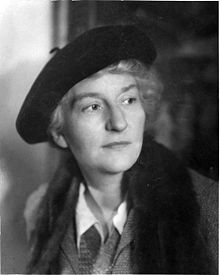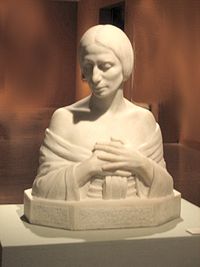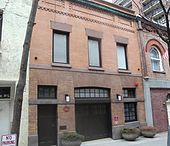- Malvina Hoffman
-
Malvina Hoffman (June 15, 1885 [1] [2] [3] , sometimes given as 1887 [4] – July 10, 1966), was an American sculptor and author, well known for her life-size bronze sculptures of people. She also worked in plaster and marble.
Stanley Field, director of the Field Museum of Natural History in Chicago, commissioned Hoffman to create sculptures of people representing members of the diverse groups of humans in cultures around the world that became a permanent exhibition at the museum entitled "Hall of the Races of Mankind", which was popular for both for its artistic and cultural values.[5] It was featured at the Century of Progress International Exposition, the Chicago World's Fair of 1933 that celebrated the centennial of the city. The museum also published a Map of Mankind, featuring her sculptures in a border surrounding a map of the world that was distributed widely with an informative, large-format booklet that made Hoffman's sculptures very well known.
Portrait busts of significant individuals of that time and depictions of people in their everyday lives were frequent works executed by Hoffman. Dancers were the subjects of the works that brought her earliest recognition and she continued to sculpt dancers throughout her career, some individuals repeatedly, such as Anna Pavlova. She was highly skilled in foundry techniques as well, often casting her own works and she published a definite work on historical and technical aspects of sculpture, Sculpture Inside and Out.
Contents
Biography
Malvina Hoffman was born in New York City, the daughter of the concert pianist, Richard Hoffman. She gravitated toward sculpture at an early age, demonstrating her talents. By the age of fourteen she was taking classes at the Art Students League of New York. She later received help from the sculptors Herbert Adams, George Grey Barnard, and Gutzon Borglum, who was a friend of her family. Another family friend, Alexander Phimister Proctor, allowed her the use of his MacDougal Alley studio for a summer.
In 1910 Hoffman moved to Europe at the age of twenty-three when her father died. Accompanying her mother, they first lived in Italy before moving to Paris. After several unsuccessful attempts, she eventually was accepted as a student by Auguste Rodin. He later convinced her to return to Manhattan to spend a year dissecting bodies at the College of Physicians and Surgeons. The education she received there was invaluable, honing her remarkable skill of rendering anatomical features that was evidenced highly when she embarked on her ambitious project to sculpt the anthropological series.
While working for the Red Cross during and after World War I, Hoffman traveled to Yugoslavia where she first met sculptor Ivan Mestrovic, with whom she would study a decade later. She was commissioned to execute several war memorials following WWI, both domestically and internationally.
Anthropological series
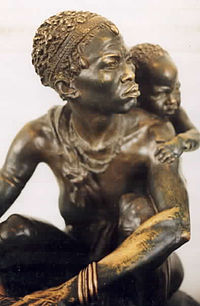 Kalahari Bushman mother and child, Field Museum, Chicago, Illinois
Kalahari Bushman mother and child, Field Museum, Chicago, Illinois
In 1930 Malvina Hoffman began working for the Field Museum of Natural History in Chicago, Illinois, sculpting life-sized statues of members of the diverse human cultural groups and she eventually completed one hundred and five sculptures, including busts, full-length figures of individuals, and small family groups for the project. Her skill at representation of the human form allowed her to render the graceful beauty of her subjects during their daily activities. This project resulted in the largest single corpus of her work.
Initially, these sculptures were set up in the Hall of Man that was established at the museum. The stories of her trips to track down the various models for each cultural group form the basis of her first book, "Heads and Tales".
However, after 30 years of display, questions began to circulate regarding the relevance of the context in which the original display was exhibited. According to American Historical Review, "the sculptures in the "Races of Mankind" had perpetuated an older typological approach by presenting "race" in the form of literally static bronze figures depicting idealized racial "types.""(Brattain, 2007). The collection was dispersed around the museum, much of it being removed from public view and relegated to storage. The retention of the sculptures by the museum provides the potential for the redisplay of the figures, if an appropriate context were developed and agreed upon.
Many of a limited series cast of smaller versions of the Hoffman life-sized anthropological sculptures, Mankind, were purchased by well-known art collectors such as, Geraldine R. Dodge, however, so appreciation for her skill in this endeavor was not lost. Several were featured in an auction held at Dodge's New Jersey estate in the late 1970s and others remain held in other private collections.
Post-World War II
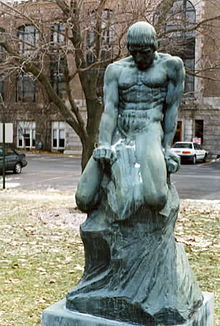 The Struggle of Elemental Man, Syracuse University, Syracuse, New York
The Struggle of Elemental Man, Syracuse University, Syracuse, New York
Following World War II, Hoffman was chosen to execute sculpture for the Epinal American Cemetery and Memorial near Vosges, France. This marks the site of bloody fighting that took place in December 1944, in what became known as, the Battle of the Bulge.
In addition to her professional talents, it is likely that Hoffman was chosen as the sculptor for this project because of the very active role she had played in the Red Cross during both WWI and WWII. Her selection also is symbolically meaningful because, during their occupation of France, the Nazis deliberately destroyed several of her commemorative works that were located in Paris.
Some of her later commemorative monuments stand at Harvard University and Syracuse University as well as at locations in London and Paris. Many of her portraits of individuals are among the collection of the New York Historical Society. She maintained a salon, a social gathering of artistic and personal acquaintances, at her Sniffen Court studio for many years.
Overview
Throughout her career, dancers fascinated Hoffman and they form the subject matter for many of her most well-known pieces although the anthropological works are the greatest in number for a single project. Many of her works were portrait busts: both of significant persons of the time and of working-class people she encountered in daily life. She often was commissioned to execute commemorative monuments and was awarded many prizes and honors. She was a member of the National Sculpture Society.
She was married to Samuel B. Grimson, often known simply as S. B. Grimson, who traveled with her during her search for authentic indigenous models for the anthropological series. Over 2,000 photographic negatives from that search are among the extensive documents of her career. Some are featured in her autobiographies.
In 1965 she published, Yesterday is Tomorrow, her final book. The next year, at the age of seventy-nine, Malvina Cornell Hoffman died while working in her studio in Manhattan, which had been purchased for her early in her career by the philanthropist Mary Williamson Averell.
Selected works
- Boy and Panther Cub, 1915 (Cedar Rapids, IA art museum)
- 105 figures for the Hall of Man, Field Museum of Natural History, Chicago, Illinois 1933
-
Kalahari Bushman, Field Museum, Chicago, Illinois
-
Navajo, Field Museum, Chicago, Illinois
-
Cock-fight, Java, Field Museum, Chicago, Illinois
- Russian Dancers
- Bacchanale Russe
- Colonel Milan Pribicevic
- Ivan Mestrovic
- The Sacrifice, Cathedral of St. John the Divine, NY, NY
- Ignace Paderesski both as The Statesman and The Artist
- Column of Life
- Bill Working
- To the Friendship of English Speaking Peoples
- several statues of the Russian dancer Pavlova, solo and with partners
- Epinal American Cemetery and Memorial, Epinal, France 1958
References
- Notes
- ^ Hill, May Brawley, ‘’The Woman Sculptor: Malvina Hoffman and Her Contempories’’, Barry-Hill Galleries Inc., NY, NY 1984 p. 29
- ^ Hill, May Brawley, ‘’The Woman Sculptor: Malvina Hoffman and Her Contempories’’, Barry-Hill Galleries Inc., NY, NY 1984
- ^ Rubenstein, Charlotte Streifer, ‘’American Women Artists: from Early Indian Times to the Present’’, Avon Publishers 1982 p. 176
- ^ Alexandre, Arsene, ‘’Malvina Hoffman’’, J.E. Pouterman, Editeur, Parios, 1930 p.11
- ^ Field Museum
- Bibliography
- Alexandre, Arsène, Malvina Hoffman, J.E. Pouterman, Éditeur, Paris 1930
- Brattain, Michelle, "Race, Racism, and Antiracism: UNESCO and the Politics of Presenting Science to the Postwar Public". The American Historical Review 112.5 (2007): 40 pars. 11 Mar. 2010.
- Connor, Janis, and Joel Rosenkranz, Rediscoveries in American Sculpture – Studio Works, 1893 – 1939, University of Texas Press, Austin 1989
- Field, Henry, The Races of Mankind, Sculptures by Malvina Hoffman, Anthropology Leaflet 30, Field Museum of Natural History, Chicago 1937
- Field Museum (January 1979). "The Legacy of Malvina Hoffman". Field Museum of Natural History Bulletin. http://biodiversitylibrary.org/page/2777476. Retrieved 15 May 2011.
- Hill, May Brawley, The Woman Sculptor, Malvina Hoffman and Her Contemporaries, The Bearley School 1984
- Hoffman, Malvina, Heads and Tales. Charles Scribner’s Sons, NY, NY 1936
- Hoffman, Malvina, Sculpture Inside and Out, Bonanza Books, NY, NY 1939
- Hoffman, Malvina, Yesterday Is Tomorrow, Crown Publishers, Inc. NY, NY 1965
- Kvaran, Einar Einarsson, Hunting Hoffman in the Field Museum, unpublished manuscript
- Nishiura, Elizabeth, American Battle Monuments – A Guide to Military Cemeteries and Monuments Maintained By the American Battle Monuments Commission, Omnigraphics, Inc, Detroit, Michigan 1989
- Proske, Beatrice Gilman, Brookgreen Gardens Sculpture, Brookgreen Gardens, South Carolina, 1968
- Rubinstein, Charlotte Streifer, American Women Sculptors’ G.K. Hall & Co. Boston 1990
External links
- Tribute to Malvina Hoffman
- Photo Archives - Malvina Hoffman Collection at the Field Museum
- Malvina Hoffman papers, 1897-1984. Research Library at the Getty Research Institute. Los Angeles, California. The collection comprises a virtually complete archive of papers relating to Hoffman’s life and career as a sculptor and writer. Correspondence traces Hoffman’s relationships with friends, such as Auguste Rodin, Ivan Mestrovic, Anna Pavlova, Jean Jacques Lemordant, Alexandre Iacovleff, and Marianne Moore, family members, and clients, as well as the development of her commissions and publications
- Malvina Cornell Hoffman entry, p. 276, Painting and Sculpture in the Collection of National Academy of Design, by David Bernard Dearinger
Categories:- 1887 births
- 1966 deaths
- American women artists
- Women sculptors
- American sculptors
- Modern sculptors
- Artists from New York City
Wikimedia Foundation. 2010.

